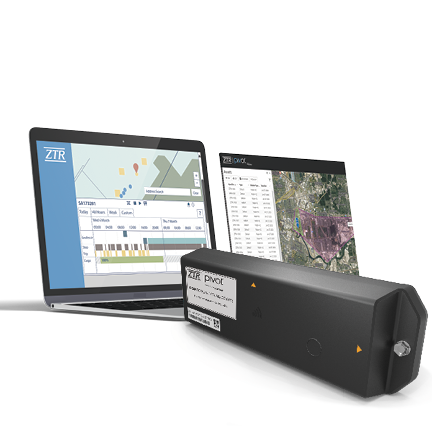In the dynamic world of rail transport, telematics systems are leading the way in transforming how goods are monitored and managed across vast distances. This powerful blend of technology ensures that rail operators can track, in real time, the whereabouts and condition of their cargo, making rail telematics an indispensable tool in the logistics toolkit.
However, with innovation comes choice, particularly when it comes to powering these crucial systems and operators are often caught between battery-powered and solar-powered solutions. While both have their advantages, battery-powered railcar telematics offer several advantages over their solar-powered counterparts in reliability, flexibility, ease of maintenance, and overall cost-effectiveness, especially under harsh operating conditions. This blog post dives into these factors that have been guiding forces for us in building Pivot, our battery-powered railcar remote monitoring system.
Reliability in Harsh Conditions

One of the most significant advantages of battery-powered systems is their impeccable reliability under any circumstances. Unlike solar-powered devices that depend on sunlight, battery-powered solutions like PIVOT are designed to brave the elements — operating flawlessly in areas with limited sunlight and under extreme weather conditions. This independence from external factors ensures that data collection and monitoring are continuous, making them indispensable for operations that cannot afford downtime.
PIVOT, leveraging BlackBerry technology, showcases how battery-powered devices can offer real-time location, door status, load status, and handbrake status of railcars irrespective of weather conditions. This is crucial for optimizing resource allocation and minimizing operational hiccups, irrespective of the environmental challenges.
Ease of Maintenance
Railroad operations are complex and time-sensitive, leaving little room for added maintenance burdens. The operational efficiency of telematics solutions is significantly influenced by their maintenance requirements. Solar-powered systems, vulnerable to efficiency drops due to dust, debris, and weather impacts, necessitate regular cleaning and maintenance. In contrast, battery-powered devices like PIVOT are essentially 'set-and-forget', designed for longevity and no maintenance between battery changes (that last up to 8 years), allowing operators to focus on what they do best—moving goods efficiently and safely. This aspect of battery-powered systems is significantly beneficial for rail operations that cover extensive routes, where accessing devices for maintenance could pose logistical challenges.
Flexibility and Adaptability
Battery-powered telematics devices offer unmatched ease of deployment on any part of a railcar, eliminating the need for stairs, vehicles, or additional equipment required for installing solar solutions, thereby saving installation time and effort.

Rail operators require solutions that can adapt to various operational needs and geographical environments, and these devices provide the necessary flexibility. Unconstrained by the need for direct sunlight, they are apt for use in a range of environments—from sun drenched plains to shadowed rail yards, dense forests, and the urban canyons of cityscapes. This adaptability is crucial for rail logistics managers and fleet managers who operate across vast territories with differing climatic conditions.
Cost-Effectiveness
While solar and battery railcar telematic devices are similarly priced, offer similar features, and claim identical battery life, the cost effectiveness needs a holistic view to evaluate which one trumps the other. The initial infrastructure and time for installation, and the periodic maintenance over the course of its life contribute a higher total cost of ownership of solar powered telematic devices. Battery-powered units, like the ones used in PIVOT, are designed to last up to 10 years without the need for replacement or extensive maintenance, offering substantial savings over time and underscoring their value as a long-term investment in operational efficiency and reliability.
A Look at Pivot

Pivot by ZTR is an advanced railcar remote monitoring solution. The Pivot railcar gateway and sensors, powered by BlackBerry, exemplify the advancements in battery-powered telematics. Built on leading-edge technology backed by over 35 years of experience in Railway and IoT from ZTR, Pivot integrates seamlessly with business systems, providing enhanced cargo security, optimized resource allocation, and near real time information about location and operational aspects of a railcar.
Wrapping up
The debate between battery and solar power for railcar telematics leans heavily towards battery-powered solutions when considering reliability, flexibility, maintenance, and cost. In the demanding field of rail transport, these factors cannot be overlooked. Companies like ZTR, with their PIVOT solution, are leading the way in providing advanced, battery-powered telematics systems that promise to transform the landscape of railcar monitoring. By prioritizing these technologies, rail operators can look forward to greater efficiency, asset utilization, and, ultimately, competitive advantage in the logistics landscape.
For fleet managers and logistics professionals looking into the future of rail monitoring, the answer is clear — battery-powered telematics systems not only meet the dynamic demands of today’s rail industry but are paving the way for tomorrow’s innovations.
If you're in the rail industry and looking to enhance your operations with reliable, flexible, and cost-efficient telematics solutions, consider exploring what PIVOT has to offer see this link or fill out this form and we’ll get in touch.